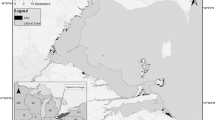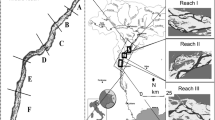Abstract
The use of remote sensing for monitoring of submerged aquatic vegetation (SAV) in fluvial environments has been limited by the spatial and spectral resolution of available image data. The absorption of light in water also complicates the use of common image analysis methods. This paper presents the results of a study that uses very high-resolution image data, collected with a Near Infrared sensitive DSLR camera, to map the distribution of SAV species for three sites along the Desselse Nete, a lowland river in Flanders, Belgium. Plant species, including Ranunculus peltatus, Callitriche obtusangula, Potamogeton natans L., Sparganium emersum R. and Potamogeton crispus L., were classified from the data using object-based image analysis and expert knowledge. A classification rule set based on a combination of both spectral and structural image variation (e.g. texture and shape) was developed for images from two sites. A comparison of the classifications with manually delineated ground truth maps resulted for both sites in 61% overall accuracy. Application of the rule set to a third validation image resulted in 53% overall accuracy. These consistent results not only show promise for species-level mapping in such biodiverse environments but also prompt a discussion on assessment of classification accuracy.
Similar content being viewed by others
References
Anders, N. S., A. C. Seijmonsbergen & W. Bouten, 2011. Segmentation optimization and stratified object-based analysis for semi-automated geomorphological mapping. Remote Sensing of Environment 115: 2976–2985.
Anderson, K. & K. J. Gaston, 2013. Lightweight unmanned aerial vehicles will revolutionize spatial ecology. Frontiers in Ecology and the Environment 11: 138–146.
Arvor, D., L. Durieux, S. Andrés & M.-A. Laporte, 2013. Advances in geographic object-based image analysis with ontologies: a review of main contributions and limitations from a remote sensing perspective. ISPRS Journal of Photogrammetry and Remote Sensing 82: 125–137.
Belgiu, M., I. Tomljenovic, T. Lampoltshammer, T. Blaschke & B. Höfle, 2014. Ontology-based classification of building types detected from airborne laser scanning data. Remote Sensing 6: 1347–1366.
Blaschke, T., 2010. Object based image analysis for remote sensing. ISPRS Journal of Photogrammetry and Remote Sensing 65: 2–16.
Blaschke, T., K. Johansen & D. Tiede, 2011. Object based image analysis for vegetation mapping and monitoring. In Weng, Qihao (ed.), Advances in Environmental Remote Sensing: Sensors, Algorithms, and Applications. CRC Press, Taylor and Francis, Boca Raton, FL: 141–266.
Blaschke, T., G. J. Hay, M. Kelly, S. Lang, P. Hofmann, E. Addink, R. Queiroz Feitosa, F. van der Meer, H. van der Werff, F. van Coillie & D. Tiede, 2014. Geographic object-based image analysis – towards a new paradigm. ISPRS Journal of Photogrammetry and Remote Sensing 87: 180–191.
d’Oleire-Oltmanns, S., I. Marzolff, D. Tiede & T. Blaschke, 2014. Detection of gully-affected areas by applying object-based image analysis (OBIA) in the region of Taroudannt, Morocco. Remote Sensing 6: 8287–8309.
Definiens AG, 2007. Definiens Developer 7 – Reference Book. http://www.ecognition.cc/download/ReferenceBook.pdf.
Drǎguţ, L., D. Tiede & S. R. Levick, 2010. ESP: a tool to estimate scale parameter for multiresolution image segmentation of remotely sensed data. International Journal of Geographical Information Science 24: 859–871.
Dronova, I., 2015. Object-based image analysis in wetland research: a review. Remote Sensing 7: 6380–6413.
Dronova, I., P. Gong, N. E. Clinton, L. Wang, W. Fu, S. Qi & Y. Liu, 2012. Landscape analysis of wetland plant functional types: the effects of image segmentation scale, vegetation classes and classification methods. Remote Sensing of Environment 127: 357–369.
Foody, G. M., 2002. Status of land cover classification accuracy assessment. Remote Sensing of Environment 80: 185–201.
Hauet, A., M. Muste & H.-C. Ho, 2009. Digital mapping of riverine waterway hydrodynamic and geomorphic features. Earth Surface Processes and Landforms 34: 242–252.
Husson, E., O. Hagner & F. Ecke, 2014. Unmanned aircraft systems help to map aquatic vegetation. Applied Vegetation Science 17: 567–577.
Kay, S., J. D. Hedley & S. Lavender, 2009. Sun glint correction of high and low spatial resolution images of aquatic scenes: a review of methods for visible and near-infrared wavelengths. Remote Sensing 1: 697–730.
Klemas, V., 2013. Remote sensing of coastal wetland biomass: an overview. Journal of Coastal Research 290: 1016–1028.
Laliberte, A. S., A. Rango, J. E. Herrick & E. L. Fredrickson, 2007. An object-based image analysis approach for determining fractional cover of senescent and green vegetation with digital plot photography. Journal of Arid Environments 69: 1–14.
Laliberte, A. S., M. A. Goforth, C. M. Steele & A. Rango, 2011. Multispectral remote sensing from unmanned aircraft: image processing workflows and applications for rangeland environments. Remote Sensing 3: 2529–2551.
Li, X. & G. Shao, 2014. object-based land-cover mapping with high resolution aerial photography at a county scale in midwestern USA. Remote Sensing 6: 11372–11390.
Lucas, M. & J. Goodman, 2014. Linking coral reef remote sensing and field ecology: it’s a matter of scale. Journal of Marine Science and Engineering 3: 1–20.
Lucieer, A., Z. Malenovský, T. Veness & L. Wallace, 2014. HyperUAS-Imaging Spectroscopy from a Multirotor Unmanned Aircraft System. Journal of Field Robotics 31: 571–590.
Luscier, J. D., W. L. Thompson, J. M. Wilson, B. E. Gorham & L. D. Drǎguţ, 2006. Using digital photographs and object-based image analysis to estimate percent ground cover in vegetation plots. Frontiers in Ecology and the Environment 4: 408–413.
Mui, A., Y. He & Q. Weng, 2015. An object-based approach to delineate wetlands across landscapes of varied disturbance with high spatial resolution satellite imagery. ISPRS Journal of Photogrammetry and Remote Sensing 109: 30–46.
Olofsson, P., G. M. Foody, M. Herold, S. V. Stehman, C. E. Woodcock & M. A. Wulder, 2014. Good practices for estimating area and assessing accuracy of land change. Remote Sensing of Environment 148: 42–57.
Radoux, J., P. Bogaert, D. Fasbender & P. Defourny, 2011. Thematic accuracy assessment of geographic object-based image classification. International Journal of Geographical Information Science 25: 895–911.
Rampi, L. P., J. F. Knight & K. C. Pelletier, 2014. Wetland mapping in the upper midwest United States. Photogrammetric Engineering & Remote Sensing 80: 439–448.
Roelfsema, C. M., M. Lyons, E. M. Kovacs, P. Maxwell, M. I. Saunders, J. Samper-Villarreal & S. R. Phinn, 2014. Multi-temporal mapping of seagrass cover, species and biomass: a semi-automated object based image analysis approach. Remote Sensing of Environment 150: 172–187.
Tiede, D., S. Lang, F. Albrecht & D. Hölbling, 2010a. Object-based class modeling for cadastre-constrained delineation of geo-objects. Photogrammetric Engineering & Remote Sensing 76: 193–202.
Tiede, D., S. Lang, D. Hölbling & P. Füreder, 2010b. Transferability of OBIA rule sets for IDP camp analysis in Darfur. The International Archives of the Photogrammetry, Remote Sensing and Spatial Information Sciences, XXXVIII-4/C7.
Verhoeven, G., 2008. Imaging the invisible using modified digital still cameras for straightforward and low-cost archaeological near-infrared photography. Journal of Archaeological Science 35: 3087–3100.
Verhoeven, G. J. J., 2010. It’s all about the format – unleashing the power of RAW aerial photography. International Journal of Remote Sensing 31: 2009–2042.
Visser, F., C. Wallis & A. M. Sinnott, 2013. Optical remote sensing of submerged aquatic vegetation: opportunities for shallow clearwater streams. Limnologica – Ecology and Management of Inland Waters 43: 388–398.
Visser, F., K. Buis, V. Verschoren & P. Meire, 2015. Depth estimation of submerged aquatic vegetation in clear water streams using low-altitude optical remote sensing. Sensors 15: 25287–25312.
Woodget, A. S., P. C. Carbonneau, F. Visser & I. Maddock, 2015. Quantifying submerged fluvial topography using hyperspatial resolution UAS imagery and structure from motion photogrammetry. Earth Surface Processes and Landforms 40: 47–64.
Acknowledgements
Funding for this project was provided by the FWO (Fund for Scientific Research)—Flanders (Belgium)—(G.0290.10) via the multidisciplinary research project ‘Linking optical imaging techniques and 2D-modelling for studying spatial heterogeneity in vegetated streams and rivers’ (Antwerp University, Ghent University, 2010–2013) and the FWO Scientific Research Community ‘Functioning of river ecosystems by plant–flow–sediment interactions’. V.V. thanks the Institute for the Promotion of Innovation through Science and Technology in Flanders (IWT-Vlaanderen) for personal research funding. J.S. is a postdoctoral fellow of FWO (Project No. 12H8616 N).
Author information
Authors and Affiliations
Corresponding author
Additional information
Guest editors: M. T. O’Hare, F. C. Aguiar, E. S. Bakker & K. A. Wood / Plants in Aquatic Systems – a 21st Century Perspective
Rights and permissions
About this article
Cite this article
Visser, F., Buis, K., Verschoren, V. et al. Mapping of submerged aquatic vegetation in rivers from very high-resolution image data, using object-based image analysis combined with expert knowledge. Hydrobiologia 812, 157–175 (2018). https://doi.org/10.1007/s10750-016-2928-y
Received:
Revised:
Accepted:
Published:
Issue Date:
DOI: https://doi.org/10.1007/s10750-016-2928-y











